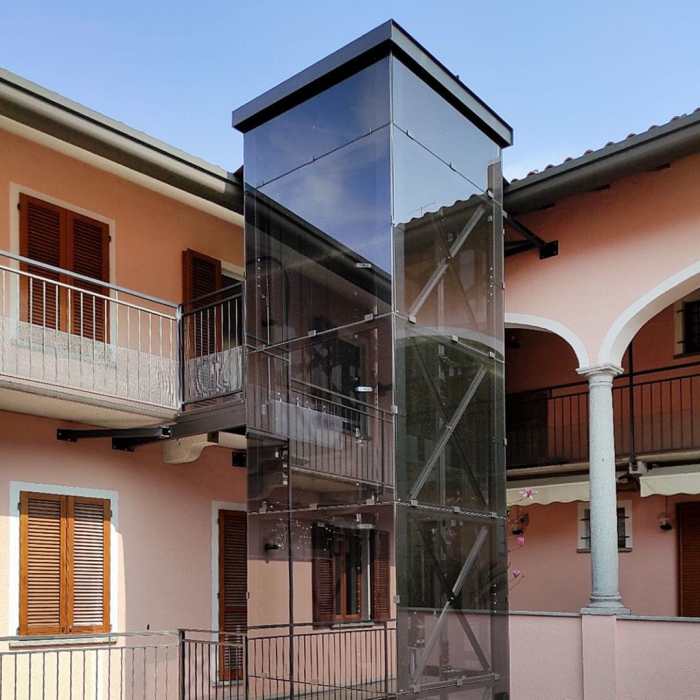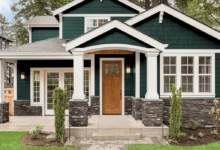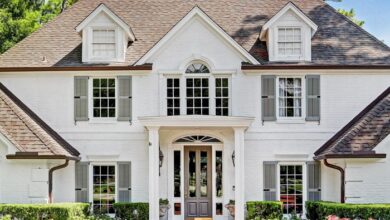Outdoor Home Elevators Access & Style
Outdoor Home Elevators are transforming how we access and experience our homes. No longer confined to the interior, these elevators offer a blend of convenience, accessibility, and architectural enhancement. Imagine effortlessly gliding between floors, enjoying scenic views from a private glass enclosure, or adding a unique design element to your property. This guide explores the various types, design considerations, safety regulations, installation processes, and costs associated with installing an outdoor home elevator, helping you navigate this exciting home improvement project.
From the sleek modern designs that complement contemporary homes to the rustic charm that enhances traditional architecture, outdoor elevators offer a versatile solution for homeowners seeking improved accessibility and increased property value. We’ll delve into the specifics of hydraulic, pneumatic, and electric models, comparing their energy efficiency, maintenance needs, and overall cost-effectiveness. Safety is paramount, and we’ll cover essential safety features and regulatory compliance to ensure peace of mind.
Finally, we’ll explore how these elevators enhance accessibility for people of all ages and abilities.
Types of Outdoor Home Elevators
Choosing the right outdoor home elevator depends on several factors, including budget, available space, and aesthetic preferences. Understanding the different types and their characteristics is crucial for making an informed decision. This section details the three main types: hydraulic, pneumatic, and electric.
Outdoor Home Elevator Types
Different mechanisms power outdoor home elevators, each with its own advantages and disadvantages. The three primary types are hydraulic, pneumatic, and electric. The following table summarizes their key features:
| Type | Mechanism | Pros | Cons |
|---|---|---|---|
| Hydraulic | Uses a hydraulic cylinder and pump to lift the elevator car. A piston within the cylinder is moved by pressurized hydraulic fluid. | Relatively simple design, smooth operation, can handle heavy loads. | Can be less energy-efficient than other types, requires a pit and a hydraulic fluid reservoir, potential for leaks and environmental concerns related to hydraulic fluid. |
| Pneumatic | Utilizes compressed air to lift the elevator car. Air pressure pushes a piston, raising the elevator. | Generally quieter than hydraulic elevators, requires less space than hydraulic systems (often no pit needed), relatively low maintenance. | Limited lifting capacity compared to hydraulic systems, air pressure fluctuations can affect performance, higher initial cost than hydraulic systems. |
| Electric | Employs an electric motor and a system of cables, pulleys, and counterweights to lift the elevator car. This is often a traction system, similar to what is used in larger buildings. | Energy-efficient, environmentally friendly, relatively low maintenance (compared to hydraulic), quieter than hydraulic systems, high lifting capacity. | More complex installation, potentially higher initial cost. |
Energy Efficiency Comparison
Hydraulic elevators are generally considered the least energy-efficient due to the energy lost in converting hydraulic power to mechanical movement. Leaks in the hydraulic system further reduce efficiency. Pneumatic elevators are also less efficient than electric elevators, as compressing air requires significant energy. Electric elevators, particularly those with regenerative braking systems (which recapture energy during descent), are the most energy-efficient option, minimizing operational costs over the long term.
For example, a home with an electric elevator might see annual energy savings of hundreds of dollars compared to a hydraulic system, depending on usage and energy prices.
Maintenance Requirements
Regular maintenance is crucial for the safe and reliable operation of any outdoor home elevator. The frequency and cost of maintenance vary depending on the type of elevator and usage.Hydraulic elevators require periodic checks for leaks, fluid levels, and pump operation. Typical maintenance might include fluid changes every few years, and the cost can range from a few hundred to over a thousand dollars per service, depending on the size and complexity of the system.Pneumatic elevators require less frequent maintenance compared to hydraulic systems.
Regular inspections of air pressure components and seals are essential. Maintenance costs are generally lower than for hydraulic elevators, often involving less specialized labor.Electric elevators require regular lubrication of moving parts, inspections of cables and pulleys, and checks of the motor and control system. Maintenance costs are moderate, with periodic inspections and servicing typically costing several hundred dollars per visit.
Preventive maintenance can significantly extend the lifespan and reduce the risk of unexpected breakdowns. For example, a yearly inspection and lubrication might cost several hundred dollars, but neglecting maintenance could lead to costly repairs in the future.
Design and Aesthetics

Source: archiexpo.com
Choosing an outdoor home elevator isn’t just about functionality; it’s about enhancing your home’s curb appeal and seamlessly integrating this modern convenience into your existing architecture. The design of your elevator should complement your home’s style, creating a cohesive and visually pleasing addition to your property. Careful consideration of materials, finishes, and landscaping integration is crucial for a successful installation.
The architectural style of your home significantly influences the design choices for your outdoor elevator. A well-integrated elevator enhances, rather than detracts from, your home’s aesthetic.
Architectural Styles and Compatible Elevator Designs
Various architectural styles can be successfully complemented by outdoor elevators. The key is choosing materials and finishes that harmonize with the overall design of the house.
- Traditional Homes: Elevators with wood paneling, perhaps stained a dark, rich color to match existing trim, or clad in stucco to match the house’s exterior. Ornate metal accents can add a touch of elegance.
- Modern Homes: Sleek, minimalist designs are ideal. Glass enclosures with brushed stainless steel framing create a contemporary look. The elevator could be integrated into a glass wall, almost disappearing into the architecture.
- Rustic Homes: Natural materials like weathered wood, stone, or metal with a rusted finish would be appropriate. The elevator could be designed to resemble a small, charming cabin or shed.
- Mediterranean Homes: Stucco or stone cladding in warm earth tones, possibly with wrought iron detailing, would complement the architectural style. Terracotta tile accents could also be incorporated.
- Victorian Homes: Intricate metalwork, stained glass panels, and decorative trim could be used to create an elevator that fits seamlessly with the ornate details of the home. A dark wood finish would complement the traditional aesthetic.
Outdoor Elevator Enclosure Designs
Three distinct enclosure designs illustrate the diverse aesthetic possibilities for outdoor home elevators.
- Design 1: The Modern Minimalist: This design features a glass enclosure with a sleek, brushed stainless steel frame. The glass panels are tinted for privacy and allow natural light to filter inside the elevator car. The stainless steel is polished to a mirror-like finish, reflecting the surrounding landscape. This design would integrate seamlessly into a contemporary home, almost disappearing into the architecture.
The landscaping around the elevator could include low-maintenance plantings and minimalist hardscaping.
- Design 2: The Rustic Retreat: This design uses reclaimed wood siding with a natural, weathered finish. The wood is complemented by black metal accents, such as the handrail and frame. The roof is a simple gabled design with cedar shingles. The landscaping around the elevator would include native plants and natural stone pathways, creating a secluded and tranquil atmosphere. This style would work well with a cabin or rustic-style home.
- Design 3: The Classic Elegance: This design incorporates stucco cladding in a warm, neutral tone, similar to the main house. Ornate wrought iron detailing is used for the handrail and frame, adding a touch of elegance. The roof is a simple hip design with dark-colored tiles. Landscaping could include manicured hedges and flowering plants, creating a formal and sophisticated look. This would be suitable for traditional or Mediterranean-style homes.
Seamless Integration with Home Styles
Successfully integrating an outdoor home elevator requires thoughtful consideration of the home’s existing architectural style. The elevator should not appear as an afterthought but rather a harmonious extension of the overall design.
For modern homes, clean lines and minimalist materials like glass and stainless steel are key. In traditional settings, wood paneling, stucco, or stone can create a cohesive look. Rustic homes benefit from natural materials such as weathered wood and stone. In each case, the color palette and detailing of the elevator should complement the existing house’s aesthetic. Careful placement of the elevator within the landscape is also important, minimizing visual disruption and maximizing its integration into the overall design of the property.
For instance, strategically placed landscaping can help to soften the visual impact of the elevator and blend it more naturally into the surroundings.
Safety and Regulations
Safety is paramount when considering an outdoor home elevator. These lifts, exposed to the elements and often situated at some height, require robust safety features and adherence to strict regulations to ensure the well-being of users and maintenance personnel. This section details the crucial safety aspects and relevant regulations for outdoor home elevator installations.
Key Safety Features of Outdoor Home Elevators
Outdoor home elevators incorporate several key safety features to mitigate risks. Emergency stop buttons, strategically placed inside and outside the elevator car, allow immediate halting in case of emergencies. These buttons directly cut power to the elevator’s motor, bringing it to a safe stop. Overload protection systems prevent the elevator from operating when carrying a weight exceeding its designed capacity.
This is typically achieved through weight sensors that trigger an automatic shutdown if the limit is breached. Weatherproofing is critical, involving the use of specialized materials and construction techniques to protect the elevator’s components from rain, snow, extreme temperatures, and other environmental factors. This includes sealed enclosures, corrosion-resistant materials, and drainage systems to prevent water accumulation. Furthermore, many modern elevators include features like backup power systems to prevent entrapment in case of power outages, and sophisticated communication systems to contact emergency services if needed.
Building Codes and Regulations for Outdoor Home Elevators
Building codes and regulations governing outdoor home elevator installations vary significantly depending on location. Compliance is crucial, and penalties for non-compliance can be substantial, including fines, stop-work orders, and even legal action. The following table provides a simplified overview. Note that this is not exhaustive and specific requirements should be verified with local authorities.
| Region | Code | Requirement | Penalty for Non-Compliance |
|---|---|---|---|
| United States (Example: California) | California Building Code (CBC) | Specific requirements for elevator pit depth, emergency lighting, and accessibility features. Detailed inspections are required. | Fines ranging from several hundred to thousands of dollars, potential for legal action, and potentially requiring demolition or significant rework. |
| Canada (Example: Ontario) | Ontario Building Code (OBC) | Similar requirements to the CBC, with emphasis on winterization and protection against extreme weather conditions. | Fines, stop-work orders, and potential for legal action from the province. |
| European Union (Example: Germany) | European Union Lift Directive (2014/33/EU) | Harmonized standards across member states, focusing on safety, accessibility, and performance. Rigorous testing and certification are mandated. | Significant fines, potential legal action, and product recall. |
Safety Procedures for Maintenance Personnel and Users
Regular maintenance is essential for safe operation. Maintenance personnel should follow strict safety protocols, including lock-out/tag-out procedures to prevent accidental energization, the use of appropriate personal protective equipment (PPE), and adherence to the manufacturer’s maintenance guidelines. Users should familiarize themselves with the elevator’s operation, emergency stop procedures, and any specific instructions provided by the installer. They should avoid overloading the elevator and report any malfunctions or unusual noises immediately.
In case of a power outage, users should remain calm and utilize any provided emergency communication systems to contact help. Regular safety inspections and training for both users and maintenance personnel are crucial to minimizing risks.
Installation and Cost
Installing an outdoor home elevator is a significant undertaking, requiring careful planning and execution. The process involves several key stages, from initial site assessment to final regulatory inspections. Understanding the steps involved and associated costs is crucial for budgeting and project management.
The total cost of installing an outdoor home elevator can vary considerably depending on several factors. These factors include the type of elevator chosen (hydraulic, traction, or pneumatic), its size and capacity, the materials used in construction, the complexity of the installation site, labor costs in your region, and the necessary permits and inspections. Accurate cost estimations require consultation with multiple elevator companies and contractors.
Step-by-Step Installation Guide
A typical outdoor home elevator installation follows these general steps. However, specific procedures may vary based on the elevator type, local regulations, and site conditions.
- Site Preparation: This involves surveying the installation site, assessing the ground conditions, and preparing the foundation. This might include excavation, concrete pouring, and grading to ensure a level and stable base for the elevator shaft.
- Shaft Construction: The elevator shaft is built, either from prefabricated materials or constructed on-site. This phase includes erecting the walls, roof, and any necessary structural supports. The shaft must meet specific safety and building code requirements.
- Elevator Installation: The elevator car, hoistway machinery (motor, cables, etc.), and control system are installed within the shaft. This is a highly specialized process requiring experienced technicians.
- Electrical and Mechanical Connections: The elevator’s electrical and mechanical systems are connected to the building’s power supply and other relevant infrastructure. This includes wiring, plumbing (if applicable), and testing all components.
- Safety System Testing: Rigorous testing of all safety systems is performed to ensure compliance with safety regulations. This includes testing emergency brakes, safety sensors, and other critical safety features.
- Final Inspection: A final inspection is conducted by local building inspectors to verify compliance with all relevant codes and regulations. This inspection typically includes a thorough examination of the elevator’s operation and safety systems.
- Landscaping and Finishing: Once the elevator is inspected and approved, final landscaping and finishing touches are added to integrate the elevator seamlessly into the home’s exterior.
Cost Breakdown
Estimating the cost of an outdoor home elevator installation requires considering numerous factors. The following table provides a general cost estimate, but actual costs can vary significantly depending on your specific circumstances. Always obtain multiple quotes from reputable contractors.
| Item | Description | Cost Estimate | Notes |
|---|---|---|---|
| Elevator Type & Size | Hydraulic, Traction, Pneumatic; Capacity (weight and number of passengers) | $20,000 – $100,000+ | Larger elevators and more advanced technology significantly increase costs. |
| Shaft Construction | Materials (steel, concrete, etc.), labor, permits | $10,000 – $40,000 | Costs depend heavily on the shaft’s size and complexity. |
| Installation Labor | Experienced elevator technicians | $10,000 – $30,000 | Labor costs vary significantly by region and contractor. |
| Permits and Inspections | Building permits, electrical inspections, safety inspections | $1,000 – $5,000 | Permitting costs vary widely by location. |
| Site Preparation | Excavation, foundation work, grading | $2,000 – $10,000 | Site conditions heavily influence these costs. |
| Total Estimated Cost | $43,000 – $185,000+ | This is a broad estimate; actual costs may be higher or lower. |
Installation Challenges and Solutions
Several challenges can arise during the installation of an outdoor home elevator. Careful planning and proactive problem-solving are crucial to mitigate potential delays and cost overruns.
- Site Limitations: Limited space, difficult terrain, or proximity to existing structures can complicate installation. Solutions may include using smaller elevator models, modifying the design, or employing specialized equipment.
- Environmental Factors: Extreme weather conditions, such as heavy rain, snow, or high winds, can delay construction. Proper planning, including weather contingency plans and protective measures, is essential.
- Unexpected Ground Conditions: Unexpectedly unstable soil or rock formations can require additional foundation work or engineering solutions. Thorough site investigation before construction is crucial.
- Regulatory Compliance: Meeting local building codes and safety regulations is paramount. Working with experienced contractors who understand these requirements is essential to avoid delays and potential fines.
Accessibility and Usage
Outdoor home elevators significantly improve accessibility for a wide range of users, transforming multi-story homes into more inclusive and comfortable living spaces. Their benefits extend beyond mere convenience, offering crucial support for individuals with mobility challenges and enhancing the quality of life for elderly residents.The integration of outdoor home elevators offers a practical solution to the challenges of navigating stairs, thereby increasing the independence and safety of homeowners.
This is particularly relevant for those with physical limitations or age-related mobility issues. The accessibility features, coupled with the enhanced usability they provide, contribute to a more comfortable and secure home environment.
Accessibility Features for Users with Disabilities
Numerous accessibility features can be incorporated into outdoor home elevators to meet the diverse needs of people with disabilities. These features are designed to ensure safe and convenient operation for a wide range of users.
- Accessible Controls: Elevators can be equipped with intuitive and easy-to-use control panels featuring large, clearly labeled buttons, Braille markings, and potentially voice commands. This ensures ease of use for visually impaired individuals.
- Spacious Cabins: Larger cabin sizes accommodate wheelchairs and other mobility aids, allowing users ample space to maneuver comfortably. The cabin’s interior should be designed to facilitate easy entry and exit.
- Emergency Communication Systems: In-cabin emergency buttons and communication systems provide direct contact with emergency services or caregivers in case of unexpected situations. This offers crucial peace of mind for users.
- Level Landing: Ensuring that the elevator car aligns perfectly with the floor level at each stop eliminates any step or gap, preventing tripping hazards and making access easier for wheelchair users.
- Smooth Operation: A smooth and gradual start and stop reduces the risk of jarring movements that can be uncomfortable or disorienting for some users.
Enhanced Accessibility for Elderly Residents
For elderly homeowners, an outdoor home elevator can be transformative. It eliminates the risks associated with climbing stairs, preventing falls and injuries. This contributes to maintaining independence and allowing seniors to continue living in their homes comfortably for longer periods.The ease of access provided by the elevator improves daily routines, allowing seniors to move freely between floors without physical strain.
This not only promotes physical well-being but also enhances their overall quality of life and reduces the risk of social isolation often associated with reduced mobility. Features like easy-to-use controls and ample cabin space specifically address the physical limitations commonly experienced by the elderly.
User Groups Benefiting from Outdoor Home Elevators
The benefits of outdoor home elevators extend to a diverse range of individuals and families. The technology directly addresses the specific needs of several user groups:
- Individuals with mobility impairments: Wheelchair users, individuals with arthritis, and those recovering from injuries or surgeries benefit greatly from the elimination of stairs. The elevator allows for independent movement throughout the home.
- Elderly residents: As mobility naturally declines with age, an elevator prevents falls and reduces the risk of injury, supporting continued independent living.
- Families with young children: Carrying young children or strollers up and down stairs can be challenging. An elevator makes this task significantly easier and safer.
- Individuals with chronic health conditions: Those with conditions like heart disease or respiratory problems find it easier to navigate a multi-story home with an elevator, reducing physical exertion.
End of Discussion
Installing an outdoor home elevator is a significant investment, but the benefits—increased accessibility, enhanced home value, and improved quality of life—often outweigh the costs. By carefully considering the various types, design options, safety regulations, and installation processes, you can make an informed decision that perfectly suits your needs and architectural style. Remember to consult with professionals throughout the process to ensure a smooth and successful installation.
With careful planning and the right expertise, your outdoor home elevator will be a seamless and stylish addition to your home, enhancing both its functionality and aesthetic appeal for years to come.
FAQ Guide: Outdoor Home Elevators
What is the average lifespan of an outdoor home elevator?
With proper maintenance, outdoor home elevators can last 20-30 years or more.
What about weather resistance? Will it withstand harsh conditions?
Yes, reputable manufacturers design elevators with robust weatherproofing to withstand various climates. Specific materials and features will vary depending on the model and location.
Are there tax credits or incentives available for installing an outdoor home elevator?
Tax credits and incentives vary by region and may be available if the elevator is installed for accessibility reasons. Check with your local government for details.
Can I customize the interior of the elevator cab?
Yes, many manufacturers offer customization options for interior finishes, lighting, and other features to match your home’s style.
How much does it cost to maintain an outdoor home elevator annually?
Annual maintenance costs vary depending on the elevator type and complexity, but typically range from a few hundred to a thousand dollars.








